The Edging Tool Market is estimated to be valued at USD 13,209.8 million in 2025 and is projected to reach USD 17,926.0 million by 2035, registering a compound annual growth rate (CAGR) of 3.1% over the forecast period.
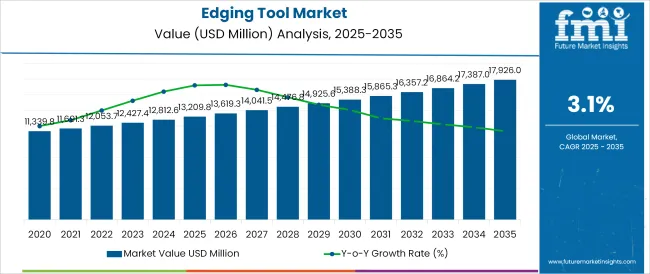
The edging tool market is gaining momentum as consumer interest in lawn maintenance, aesthetic landscaping, and property value enhancement continues to rise, especially in suburban and residential zones. Increasing homeownership, growing participation in do it yourself (DIY) gardening, and social media-driven outdoor beautification trends are encouraging consumers to invest in compact, efficient, and user-friendly edging solutions.
Manufacturers are responding by introducing ergonomic, low-maintenance tools with enhanced safety features, while also expanding their presence through direct-to-consumer channels. Affordability remains a strong market driver, especially for seasonal or occasional users, prompting development of tools under strategic pricing tiers.
Sustainability goals and noise reduction considerations are leading to increased adoption of manual and electric variants. With growth extending to emerging markets driven by urban greening initiatives and lifestyle improvements, future opportunities lie in multi-functionality, tool customization, and direct e-commerce engagement across both developed and developing regions.
The market is segmented by Application, Price Range, and Distribution Channels and region. By Application, the market is divided into Residential, Commercial, Industrial, Automotive, Furniture, and Others. In terms of Price Range, the market is classified into Low (Under-USD 50), Medium (USD 50-USD 100), and High (USD 100 & above).
Based on Distribution Channels, the market is segmented into Direct Sales, Retail Sales, Online retailing, Specialty Store, and Others. Regionally, the market is classified into North America, Latin America, Western Europe, Eastern Europe, Balkan & Baltic Countries, Russia & Belarus, Central Asia, East Asia, South Asia & Pacific, and the Middle East & Africa.
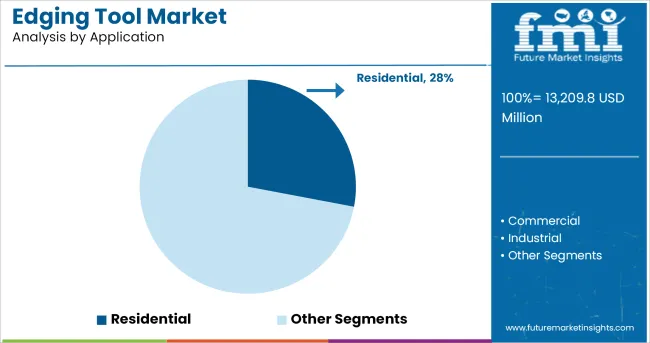
In terms of application, the residential segment is projected to hold a 28.0% revenue share in 2025, making it the leading usage category in the edging tool market. This prominence is being driven by increased residential construction, rising outdoor living investments, and growing popularity of at home landscaping.
Consumers are becoming more engaged with personal lawn care for reasons ranging from curb appeal to property maintenance. The accessibility of edging tools both in terms of ease of use and availability has made them popular among DIY homeowners and gardening enthusiasts.
Lightweight design, adjustable features, and safety enhancements have contributed to rising household adoption. Additionally, seasonal demand during peak growing periods and promotional activity through home improvement retailers has helped the residential segment maintain its lead in market contribution.
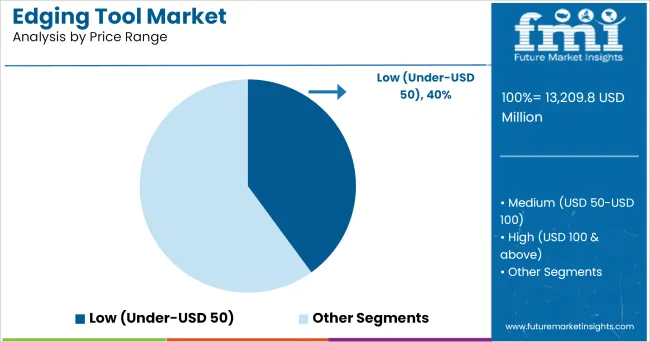
The low price range segment, comprising products under USD 50, is forecast to account for 40.0% of the edging tool market revenue in 2025, establishing itself as the top pricing tier. This leadership is due to the segment’s broad accessibility, especially among first-time buyers and casual users. Affordability in this category has allowed consumers to experiment with lawn maintenance tools without significant financial commitment.
Manufacturers are achieving economies of scale by producing durable yet simple manual and entry level electric models for mass distribution. Price-sensitive markets, such as small town and suburban households, have responded favorably to these cost-effective offerings.
As online platforms and seasonal retail promotions expand reach, the under USD 50 category continues to attract volume sales, reinforcing its dominant share in the market landscape.
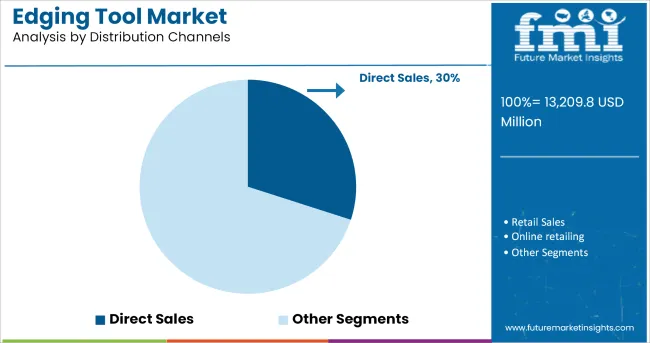
Direct sales channels are projected to contribute 30.0% to overall edging tool market revenue in 2025, positioning them as the leading distribution model. This segment’s growth has been driven by the rising popularity of manufacturer to consumer business models that emphasize convenience, personalized service, and price transparency.
Tool makers are leveraging e-commerce platforms, social media storefronts, and branded websites to engage directly with consumers, bypassing traditional retail mark ups. Additionally, direct feedback loops and product education via virtual consultations or content marketing have improved customer retention and brand loyalty. For niche and specialty toolmakers, direct sales have enabled higher margins and faster go to market timelines.
As customer preferences shift toward digital interaction and value added purchase experiences, the direct sales channel is expected to retain its strategic importance in the edging tool market.
Increasing the infrastructure building by favorable macro-economic conditions such as increasing access to credit, increasing disposable income and low-interest rates drive the edging tool market. These edging tools are helpful to make clean and quick paint edges around window trim, baseboards, ceilings and doors.
Furthermore, rapid advancement in technology improved the design of painting products including edging tools. Also, many prominent players invested in the research and development activity to launched advance edging tools.
For instance, EMERY EDGERS has developed a painting tool that dramatically outperforms other competitors. The company designed a painting tool to quickly paint perfect edges without tape. The company claims that its edger is able to tackle 100% of trim. This helps the company to attract more customers in the market and gain a competitive advantage.
Good and clean paint of living space helps the member to improve their hospitality and increases the motivation and interest level towards the work. Furthermore, edging tools keep the ceiling trim and clean.
In ancient time painter cover or tape the edges of the baseboard, window and door trim, ceiling before cutting in the perimeter. Instead with the painting edging tool time as well as the tape is saved.
Furthermore, the growing population of millennials and youth is also the influencing factor for growing the trade of painting tools around the globe. As these generations are regularly using social media platforms, where they find more ideas for the new product launch in the market and also, get to know about the benefits of the edging tools.
For the same, players are also strengthening their presence on social media accounts to update their new launches for more familiar to the customers and encourage them to purchase the products.
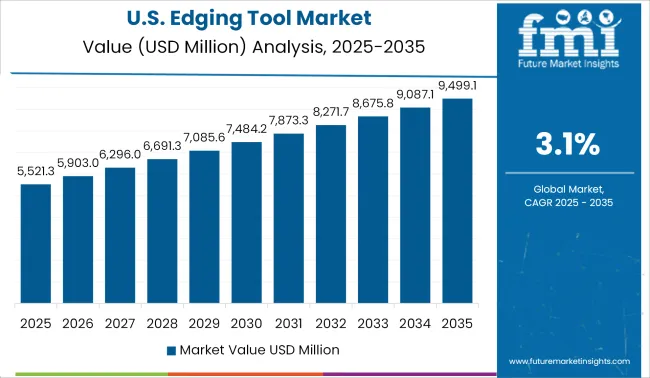
The USA and Canada governments have taken a number of efforts to interrupt the coronavirus's immunoassay chain of transmission sales and stop it from spreading, including imposing curfews and lockdowns, as well as closing international trade.
However, because the majority of individuals in the United States work from home and have free weekends, the majority of people are redesigning their homes during the pandemic, allowing the players to earn more money. Due to expanding client interest, demand for painting tools and accessories and the do-it-yourself trend is increasing in the United States.
Due to the fast-changing lifestyle and urbanization, the possessions of the houses are also growing in the United State and this factor has fueled the market of edging tools in the next ten years.
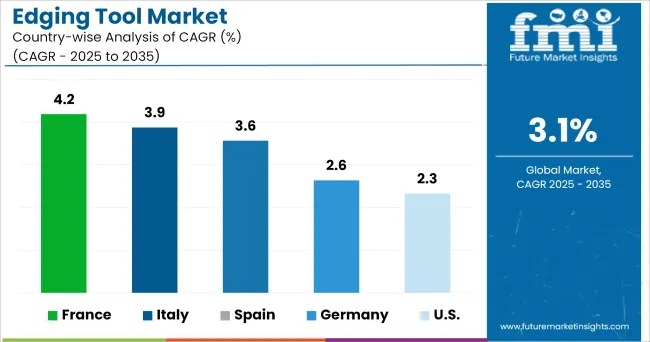
Europe is the primary market for painting tool accessories including edging tools. The increasing investment in the infrastructure and construction sectors including residential, commercial and industrial buildings in the region are driving the market demand.
Furthermore, the growth of the real estate industry in Europe is another factor responsible for the growth of the edging tool market. The majority of European people are accessing e-commerce platforms for easy access to painting products as well as wider availability of accessories has also fueled the trade growth.
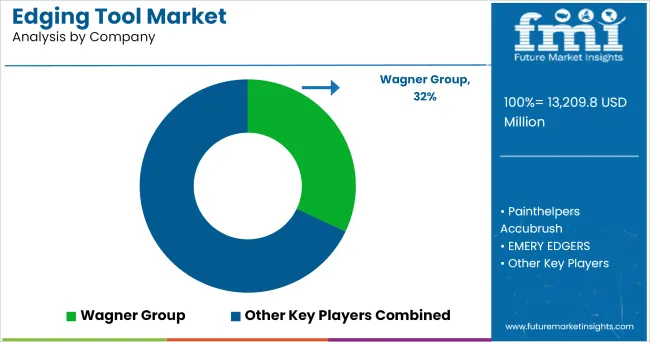
The global market share of painting tools including edging tools is highly competitive due to the presence of prominent players in the market. Some of the leading manufacturers and suppliers of edging tools include
The key players are involved in various business portfolio expansions, new product launches, long-term agreements and mergers and acquisitions to gain a competitive advantage in the market.
The report is a compilation of first-hand information, qualitative and quantitative assessment by industry analysts, inputs from industry experts and industry participants across the value chain. The report provides in-depth analysis of parent market trends, macro-economic indicators and governing factors along with market attractiveness as per segments. The report also maps the qualitative impact of various market factors on market segments and geographies.
The global edging tool market is estimated to be valued at USD 13,209.8 million in 2025.
The market size for the edging tool market is projected to reach USD 17,926.0 million by 2035.
The edging tool market is expected to grow at a 3.1% CAGR between 2025 and 2035.
The key product types in edging tool market are residential, commercial, industrial, automotive, furniture and others.
In terms of price range, low (under-usd 50) segment to command 40.0% share in the edging tool market in 2025.






Our Research Products

The "Full Research Suite" delivers actionable market intel, deep dives on markets or technologies, so clients act faster, cut risk, and unlock growth.

The Leaderboard benchmarks and ranks top vendors, classifying them as Established Leaders, Leading Challengers, or Disruptors & Challengers.

Locates where complements amplify value and substitutes erode it, forecasting net impact by horizon

We deliver granular, decision-grade intel: market sizing, 5-year forecasts, pricing, adoption, usage, revenue, and operational KPIs—plus competitor tracking, regulation, and value chains—across 60 countries broadly.

Spot the shifts before they hit your P&L. We track inflection points, adoption curves, pricing moves, and ecosystem plays to show where demand is heading, why it is changing, and what to do next across high-growth markets and disruptive tech

Real-time reads of user behavior. We track shifting priorities, perceptions of today’s and next-gen services, and provider experience, then pace how fast tech moves from trial to adoption, blending buyer, consumer, and channel inputs with social signals (#WhySwitch, #UX).

Partner with our analyst team to build a custom report designed around your business priorities. From analysing market trends to assessing competitors or crafting bespoke datasets, we tailor insights to your needs.
Supplier Intelligence
Discovery & Profiling
Capacity & Footprint
Performance & Risk
Compliance & Governance
Commercial Readiness
Who Supplies Whom
Scorecards & Shortlists
Playbooks & Docs
Category Intelligence
Definition & Scope
Demand & Use Cases
Cost Drivers
Market Structure
Supply Chain Map
Trade & Policy
Operating Norms
Deliverables
Buyer Intelligence
Account Basics
Spend & Scope
Procurement Model
Vendor Requirements
Terms & Policies
Entry Strategy
Pain Points & Triggers
Outputs
Pricing Analysis
Benchmarks
Trends
Should-Cost
Indexation
Landed Cost
Commercial Terms
Deliverables
Brand Analysis
Positioning & Value Prop
Share & Presence
Customer Evidence
Go-to-Market
Digital & Reputation
Compliance & Trust
KPIs & Gaps
Outputs
Full Research Suite comprises of:
Market outlook & trends analysis
Interviews & case studies
Strategic recommendations
Vendor profiles & capabilities analysis
5-year forecasts
8 regions and 60+ country-level data splits
Market segment data splits
12 months of continuous data updates
DELIVERED AS:
PDF EXCEL ONLINE
Dredging Market Size and Share Forecast Outlook 2025 to 2035
Dredging Equipment Market Size and Share Forecast Outlook 2025 to 2035
Tool Holders Market Size and Share Forecast Outlook 2025 to 2035
Tool Box Market Size and Share Forecast Outlook 2025 to 2035
Tool Tethering Market Size and Share Forecast Outlook 2025 to 2035
Tool Steel Market Size and Share Forecast Outlook 2025 to 2035
Tool Presetter Market Trend Analysis Based on Product, Category, End-Use, and Region 2025 to 2035
Understanding Market Share Trends in the Tool Box Industry
Tool Holder Collets Market
Tool Chest Market
Stool Management System Market Analysis - Size, Share, and Forecast Outlook 2025 to 2035
CNC Tool Storage System Market
Hand Tools Market Size and Share Forecast Outlook 2025 to 2035
Key Players in the Hand Tools Market Share Analysis
Power Tools Market Size and Share Forecast Outlook 2025 to 2035
Smart Tools Market Size and Share Forecast Outlook 2025 to 2035
Power Tools Industry Analysis in India - Size, Share, and Forecast Outlook 2025 to 2035
Power Tool Gears Market - Growth & Demand 2025 to 2035
Baking Tools Market Size and Share Forecast Outlook 2025 to 2035
Rotary Tool Market Size and Share Forecast Outlook 2025 to 2035

Thank you!
You will receive an email from our Business Development Manager. Please be sure to check your SPAM/JUNK folder too.
Chat With
MaRIA